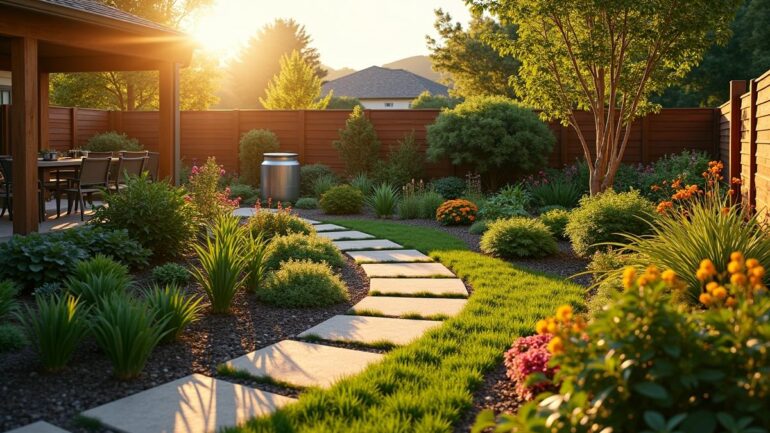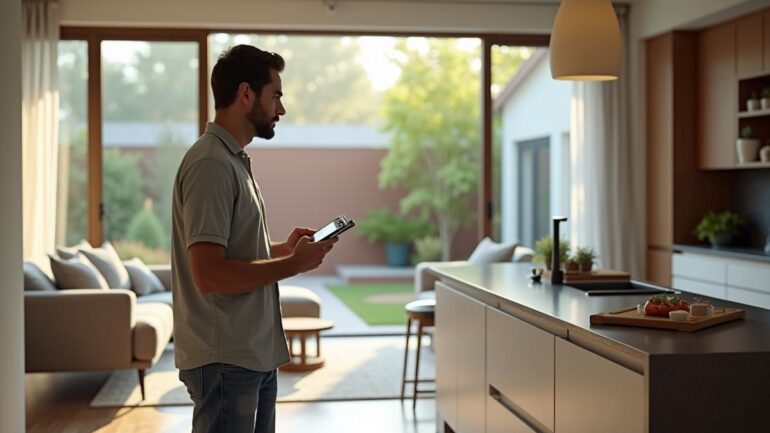Eco-Friendly Ideas are taking center stage in yard design, transforming outdoor spaces into thriving havens of green living and sustainable practices. Modern homeowners are focusing on low-impact lifestyle choices that embrace nature-friendly elements and encourage resource conservation. Creating an environmentally conscious yard goes beyond simple landscaping—it involves mindful decisions about water usage, clean energy sources, and organic materials that nurture both your family and the planet.
Sustainable Living in Your Yard
Sustainable living applies to every corner of your property, and your yard is an excellent place to start. Individuals who adopt gentle gardening methods and prioritize environmentally conscious landscaping often observe substantial carbon footprint reduction. This shift can also inspire friends and neighbors to follow suit, further amplifying conservation efforts in your community.
When planning a yard with eco-conscious principles, consider planting native species suited to your local climate. They typically require less water and are better able to resist local pests, reducing reliance on chemical pesticides. This method encourages biodiversity and supports pollinators like bees and butterflies, enhancing your outdoor experience. By favoring drought-tolerant shrubs and groundcovers, you also work toward water conservation.
Building Soil Health
Rich soil forms the foundation of any flourishing yard. Healthy soil improves water retention and supports robust root systems. Composting kitchen scraps and gathering leaf litter are basic zero waste measures that enrich your yard’s soil while cutting down on landfill waste. This recycled organic matter provides nutrients for your plants, letting them thrive without harsh fertilizers. Maintaining vibrant soil also reduces erosion, contributing to broader environmental sustainability.
Choosing Green Products and Biodegradable Materials
Selecting green products is a straightforward way to bolster an eco-friendly home landscape. Conventional materials often rely on harmful chemicals, but biodegradable products offer safer alternatives. From planter pots to mulching materials, there is a wide variety of resource-friendly items available. By integrating these into your yard design, you promote nature-friendly living while minimizing negative environmental impact.
Biodegradable landscaping fabrics are one example of a practical swap. These fabrics suppress weed growth, prevent moisture from escaping, and gradually break down, leaving no damaging residues in your soil. Another favorable option is using wood chips or straw as mulch. Natural mulches control weeds and help the soil retain water, reducing the need for regular irrigation.
Alternatives to Chemicals
Fertilizers and pesticides often introduce toxins that harm beneficial insects and disrupt delicate ecosystems. Natural cleaning products and eco-friendly DIY garden solutions use ingredients such as vinegar, essential oils, or soap nut extracts to deter pests. Because these aren’t heavy on synthetic chemicals, your yard’s microclimate remains healthy for birds, bees, and amphibians. Adopting these methods keeps your yard aligned with sustainable energy goals, because you rely less on petroleum-based fertilizers.
Water Conservation and Renewable Energy in Outdoor Spaces
Preserving water is a key component of environmental sustainability, and your yard can become a model for efficient water use. Installing rain barrels beneath gutter spouts allows you to catch rainwater for irrigating lawns and garden beds, reducing your dependence on municipal supplies. This straightforward measure helps you embrace a low-impact lifestyle while cutting water bills.
Green transportation methods often highlight renewable energy, but you don’t have to limit that concept to cars or bicycles. Outdoor lighting systems that rely on solar panels demonstrate the same principle in your yard. By harnessing renewable resources, such as the sun, you energize garden lights or small water features without driving up conventional electricity usage. Solar-powered pathways also offer a pleasant ambience for nighttime gatherings, reinforcing a sense of eco-conscious living.
Drip Irrigation Techniques
Traditional sprinkler systems can waste a lot of water. In contrast, drip irrigation responsibly targets plants’ root zones, minimizing evaporation and runoff. This setup delivers water where it’s needed most, ensuring plant roots stay hydrated without excessive consumption. Pair drip systems with periodic checks for leaks to achieve maximum energy efficiency and conservation of resources.
Enhancing Your Yard with Organic Gardening and Upcycling Ideas
Organic gardening takes the idea of green living outside the bounds of a simple lawn. By avoiding synthetic fertilizers and pesticides, you foster healthier soil and protect crucial pollinators. Organic practices integrate seamlessly with upcycling ideas, turning yard waste or recycled household items into planters, trellises, or compost bins. This blend of frugality and creativity spares you unwanted expenses while giving your yard a personal touch.
Tending an eco-friendly vegetable plot can also support a plant-based diet and reduce the overall carbon emissions referenced in typical food supply chains. When vegetables travel just a few steps from your garden to the dinner table, you cut down on packaging and transportation, aligning with zero waste principles. This approach also lets you control what goes into your food, ensuring it remains free from toxic chemicals.
Companion Planting Strategies
A key aspect of organic gardening is companion planting—growing certain plant pairs together to help repel pests or enhance growth. For example, marigolds can protect tomatoes by deterring harmful insects. With thoughtful companion planting, you minimize the need for chemical sprays and foster a healthier, self-sustaining environment. This strategy exemplifies how smaller adjustments can ripple outward into bigger conservation efforts.
Inspiring Eco-Friendly DIY Projects and Ethical Consumption at Home
Engaging in eco-friendly DIY activities is not limited to crafty upcycling. From building raised garden beds with salvaged wood to assembling compost tumblers from large plastic drums, these projects can serve as powerful demonstrations of ethical consumption. Reusing materials also reinforces the stable loop of recycling, essential to both local sourcing and planet-wide endeavors.
Think about including a greenhouse or cold frame in your yard, constructed with reclaimed windows or doors. This approach lowers waste and extends your growing season, letting you produce vegetables in cooler months. Additionally, you can explore small-scale aquaponics or self-watering containers for an innovative spin on sustainable living.
Responsible Disposal and Recycling Tips
Even with original efforts to reduce waste, some items may not find a second life. Embrace local recycling tips, which include thorough rinsing of recyclables and proper sorting of paper, plastic, and metal. Seek out community-based recycling programs that handle hard-to-recycle items, like electronics or batteries, to ensure fewer harmful substances end up in landfills. Following these steps goes hand in hand with being environmentally conscious and maintaining an eco-friendly home.
From Your Yard to the World: Connecting Community and Green Transportation
Extending your yard’s influence beyond property lines can spark a collective interest in environmental responsibility. Neighbors may see how eco-friendly DIY projects, upcycling, and the use of biodegradable materials elevate your outdoor space. You might attract conversations about green transportation or the virtues of local sourcing to support neighborhood businesses. Small programs like seed exchanges or produce swaps can inspire others to pursue mindful and sustainable fashion, transforming entire communities into advocates for a cleaner planet.
Fostering a Shared Green Spirit
Hosting mini-events, such as yard tours or gardening workshops, can help spread knowledge about zero waste initiatives and renewable energy integration. People appreciate hands-on demonstrations of sustainable practices, from composting basics to strategies for water conservation. These gatherings heighten everyone’s sense of eco-conscious engagement and strengthen the belief that individual efforts can add up to meaningful environmental change.
Simple Ways to Include Renewable Energy in Yard Projects
Installing solar-powered water fountains or using small wind turbines to power decorative lights are enjoyable ways to bring renewable energy into typical yard tasks. These features help you harness clean energy while adding a pleasant focal point to your outdoor area. Start small with a few low-energy devices, then expand to more substantial equipment if it suits your space.
Climate-appropriate landscaping elements like stone paths, gravel beds, and woodland patches reduce the need for constant watering while making the yard functional and appealing. Incorporating these features with an emphasis on energy efficiency often produces a yard that aligns seamlessly with your eco-friendly home’s overall ethos.
Building Habits That Last
Sustainable changes survive the test of time when they blend with daily habits. Create a schedule for checking your irrigation system, garden pests, and fertilizer usage. Save seeds from your favorite plants for next season, encouraging a long-term, cyclical process of growth. Over time, nurturing these habits becomes second nature, bringing you closer to carbon footprint reduction and a lifestyle of responsible resource management.
Looking Ahead: Merging Creativity with Conservation Efforts
By exploring fresh strategies like aquaponics, vertical gardening, or rain gardens, you can transform your yard into a living laboratory for green products and forward-thinking design. As you advance, consider the role of sustainable fashion principles in your home environment: upcycled textiles can appear as weatherproof cushions or garden banners, offering color and flair without sparking waste.
Even your choice of outdoor furniture can reflect ethical consumption values. Pieces made of reclaimed wood or metal often cost less than brand-new items, while still exuding a tasteful, unique style. And if you ever outgrow certain furniture, passing it on to a neighbor or community group perpetuates the cycle of reuse that lies at the heart of zero waste practices.
Small Steps Make Big Changes
It can help to regularly evaluate your yard’s progress, from tracking how much water you collect in rain barrels to observing changes in local pollinator populations. Celebrate these achievements as significant milestones in your commitment to an eco-friendly home. Every new season invites opportunities to refine your yard’s layout, introduce fresh plant varieties, and experiment with neighborhood collaborations that support a shared vision of environmental sustainability.
Embracing these eco-conscious methods and exploring innovative improvements will ensure your yard remains a place of genuine beauty and harmony. As you continue integrating local sourcing, natural cleaning products, and new energy solutions, your outdoor space can become a practical example of how everyday people make a remarkable difference, one small project at a time.





